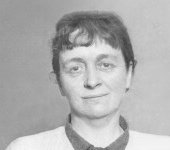
Summary
Anne Crawford Acheson CBE FRBC[1] (5 August 1882 – 13 March 1962) was a British-Irish sculptor. She and Elinor Hallé invented plaster casts for soldier's broken limbs. Acheson exhibited at the Royal Academy and internationally. She was awarded the CBE in 1919. During the First World War she worked for the Surgical Requisites Association at Mulberry Walk in Chelsea, London.[2] Acheson received the Gleichen Memorial Award in 1938.[3] She divided her time between London and Glenavy, County Antrim, Northern Ireland.[4][5]
Anne Acheson | |
|---|---|
 Anne Crawford Acheson | |
| Born | 5 August 1882 |
| Died | 13 March 1962 (aged 79) |
| Nationality | British Irish |
| Education | Belfast School of Art, Royal College of Art |
| Known for | Medical plaster and Sculpture |
Career edit
Acheson was born at Portadown in County Armagh to John Acheson, a manufacturer, and his wife, Harriet Glasgow.[6] The Achesons lived at 51 Carrickblacker Rd, Portadown, Co Armagh.[7] Anne Acheson was educated at Victoria College, Belfast, the Belfast School of Art and the Royal College of Art in London where she studied sculpture under Édouard Lantéri.[8]
Acheson first exhibited at the Royal Academy in 1913, when her sculpture The Pixie was accepted. Over the next four decades, 30 of her sculptures were featured in 22 exhibitions at the Academy.[5] Acheson's work included statuettes, portrait heads, and garden figurines.[6] While her early works were sculpted from wood, her later sculptures were largely done in metal, stone or concrete. [6]
Wartime services edit
During the First World War she volunteered with the Surgical Requisites Association. The association supplied medical dressings and had been created by Queen Mary's Needlework Guild. Acheson and Elinor Hallé were both sculptors[9] and they witnessed soldiers returning from the front with broken limbs held together with only wooden splints and basic bandages, Acheson suggested taking a plaster cast of the limb and when the cast had hardened, wrapping papier-mache over it, and placing it over the broken limb to support it whilst healing. This was inspired by the plaster of Paris she used in her sculptural work. The anatomically correct papier-mache splint reduced the healing time while properly supporting the broken limb. The idea of using plaster of Paris was adopted and refined over the years and is still in use today by the medical profession.[10] When she completed her studies, Acheson taught at a school in London and continued to live in that city.
She was the first woman, in 1938, to be elected a fellow of the Royal British Society of Sculptors.[11]
Acheson retrained as a precision engineer and draftswoman during the Second World War to enable her to carry out further voluntary work. She also worked for the Red Cross during the conflict.[12]
After the war Acheson continued as an artist practicing in Northern Ireland.[11]
Commemoration edit
A blue plaque commemorating her achievements was unveiled at First Presbyterian Church, Bridge Street, Portadown on 27 September 2018 by her great nephew, Rev John Glasgow Faris.[10][12]
An exhibition, Anne Acheson: A Sculptor in War and Peace, was held at Millennium Court Arts Centre in Portadown during April and May in 2019.[13]
Works edit
Dates for works refer to when they were first exhibited.
- The Pixie (1910)
- The Leprechaun (1914)
- Echo Mocking (1914)
- Sally (circa 1923)
- The Imp (1924)
- Trio (1924 presumed)
- Lead Mask for Garden Decoration (1924 presumed)
- The Gossamer Thread (1924 presumed)
- Tangle (Pewter Statuette) (1926)
- Mischief (1927)
- Flora M'Flimsy (1927)
- Gertrude Bell (bust for Gertrude Bell Memorial) (circa 1926–1929)
- Harriet Emily (Lead Garden Figure) (1930)
- Harriet Glasgow Acheson, Bronze Medallion (1934)
- Barbara (Glazed Pottery) (1936)
- Saint Brigit (Glazed Pottery) (1936)
- Mother and Child (Glazed Pottery) (1936)
- Harriet Emily (1938)
- Fountain figure (circa 1944)
- The Sacred Bull (1948)
- Virginia (1949)
- Squirrel (1950, presumed)
- River Nymph (Walnut Wood) (1950)[2]
Further reading edit
- The First Lady of Mulberry Walk: The Life and Times of Irish Sculptress Anne Acheson David Llewellyn, Troubador Publishing Ltd, 2010 ISBN 1848764057
References edit
- ^ "Personal Paragraphs". Aberdeen Journal. British Newspaper Archive. 24 June 1938. Retrieved 27 June 2014.
- ^ a b "Anne Crawford Acheson CBE, ARBSA". Mapping the Practice and Profession of Sculpture in Britain and Ireland 1851–1951. Retrieved 4 March 2011.
- ^ Frances Spalding (1990). 20th Century Painters and Sculptors. Antique Collectors' Club. ISBN 1-85149-106-6.
- ^ "Anne Acheson profile". Ashtead Pottery. Archived from the original on 8 March 2016. Retrieved 6 July 2009.
- ^ a b Devlin, Patrick. "'Anne Crawford Acheson (1882–1962): Sculptor' in The Dictionary of Ulster Biography". www.newulsterbiography.co.uk. Retrieved 21 April 2018.
- ^ a b c Sara Gray (2019). British Women Artists. A Biographical Dictionary of 1000 Women Artists in British Decorative Arts. Dark River. ISBN 978-1-911121-63-3.
- ^ Her parents are on 1901 census at that address.
- ^ "Miss Anne Acheson" Times [London, England] 16 March 1962: 15. The Times Digital Archive. Web. 21 April 2018.
- ^ a b "Surgical Requisites Association". Bath War Hospital. 13 February 2017. Retrieved 19 July 2019.
- ^ a b "Portadown honours Anne Acheson who invented plaster cast for bones". BelfastTelegraph.co.uk. ISSN 0307-1235. Retrieved 28 September 2018.
- ^ a b McTear, Ian (4 November 2018). "The sculptor who mended shattered bones". Retrieved 19 July 2019.
- ^ a b "Anne Acheson remembered with Blue Plaque unveilled at church". Retrieved 28 September 2018.
- ^ Holland, Mairead (8 April 2019). "The Armagh sculptor whose treatment for broken bones is still used 100 years on".


